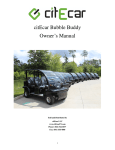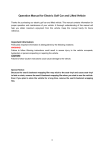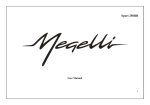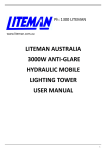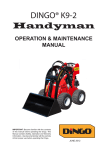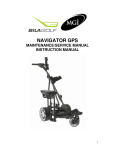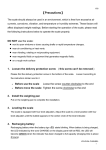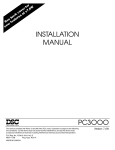Download Sport Golf Cart Manual - citEcar Electric Vehicles
Transcript
citEcar Street Legal Golf Cart Owner’s Manual – Sport Edition Sold and Distributed by citEcar LLC www.citEcarEV.com Phone: (866) 542-8677 Fax: (843) 556-4080 1 Preface Thanks for purchasing a citEcar electric vehicle. This manual contains information for proper operating, maintaining and caring of your electric vehicle. A thorough understanding of this manual will help you to obtain maximum enjoyment from this electric vehicle. Please keep it properly stored for future reference. Important Information: Particularly important information is distinguished by the following notations: WARNING! Failure to follow Warning instructions could result in severe injury to the vehicle occupants, bystanders or persons inspecting or repairing the vehicle. CAUTION! Failure to follow Caution instructions could cause damage to the vehicle. Special Notices: Because the seat & backrest wrapping film may stick to the seat vinyl and cause seat vinyl to become stained, please remove the seat & backrest wrapping film when you receive the vehicle. 2 INDEX 1. Overview ...................................................................................................................................... 4 2. Controls ........................................................................................................................................ 6 3. Operation ................................................................................................................................... 11 4. Safe Operation Instructions ....................................................................................................... 11 5. Maintenance .............................................................................................................................. 12 5.1 Maintenance of Battery ....................................................................................................... 12 5.2 Operation and Maintenance of Charger ............................................................................. 16 5.3 Maintenance of the Traction Motor ..................................................................................... 17 5.4 Maintenance of the Speed Controller: ................................................................................ 18 5.5 Diagnostics and Troubleshooting ........................................................................................ 19 5.6 Maintenance of Rear Axle: .................................................................................................. 19 5.7 Wheel Replacement ............................................................................................................ 22 5.8 Brake Adjustment ................................................................................................................ 23 6. Lubrication .................................................................................................................................... 23 7. Running-in of New Vehicle ........................................................................................................... 23 8. Periodic Maintenance Charts ..................................................................................................... 244 9. Location of Fuses ......................................................................................................................... 25 10. Storage ....................................................................................................................................... 26 11. Wiring Diagram ........................................................................................................................... 26 3 1. OVERVIEW Our vehicle is environmentally friendly, and it can be used as people mover or utility car at a golf course, vacation villages, villa areas, resort hotels, private residential areas, tourist scenic spots, or any other places where it is allowed. WARNING! Please always be sure as to whether there is any restriction in the area where you intend to use the vehicle to avoid any unpleasant experience. IMPORTANT LABELS SAFETY LABEL Read carefully and understand the contents on the safety label attached on the vehicle. Label above is attached on the dash panel as shown below: Vehicle Information (Name Plate) The name plate is located at the lower part of the steering column cover as shown below. 4 Chassis number of the vehicle The chassis number of the vehicle is printed on the right side of the right beam and above the rear right wheel as picture below shows. VIN and ID number The VIN and ID number of the vehicle are printed on the left side of the left beam and above the rear left wheel as the picture below shows. 5 2. Controls 1. Schematic Figure of controls Fig. 1 Fig. 2 Fig. 3 6 Fig. 4 Fig. 5 2. Function of the controls Ignition key —— The Ignition key is used to “power up” or “switch on” the electrical system of the vehicle. This ignition has two positions. Insert the key and turn it clockwise to the first (I) position to engage the 12V accessory system (including the headlight, turn signal, taillight, brake light, horn, wiper and digital meter); turn it clockwise further to the second (II) position to engage the motor and to drive the vehicle. To switch the power off, turn the key counterclockwise to “B” position and pull out the key to turn it off. Note: Only when you pull out the key, the 12V accessory system will be powered off completely. CAUTION! When the Key is on the ‘I’ and ‘II’ position, the key cannot be pulled out. Don’t try to pull out the key when it is on ‘I’ and ‘II’ position Accelerator pedal —— It is used to control the speed. Push it down gradually to increase the speed. The vehicle will speed up with the gradual stepping down of the accelerator pedal, eventually reaching the full speed when the pedal is stepped down to the bottom. The vehicle slows down with the releasing of the pedal. Ref. photo to right. 7 Brake Pedal —— It is used to decelerate the vehicle. Push the brake pedal to decelerate the vehicle and stop the vehicle if needed. Hand brake for parking —— the hand brake is used for parking. The hand brake should be engaged into the parking position whenever the vehicle is left unattended: pull up the hand brake to the end position in order to park the vehicle completely. This operation will make the vehicle stay in parking position when the vehicle is unattended. WARNING! Do not drive the vehicle when the hand brake is engaged! Always check and release the hand brake before driving. Failure to do this will cause the motor to burn. How to engage and disengage the parking brake? • To engage the parking brake - pull up the hand brake lever to the end. • To disengage the parking brake - pull up the hand brake lever to the end and then press down the button on the top of the brake lever, with the button being pressed down, push down the brake lever to the bottom. Engage Disengage Steering wheel —— the steering wheel is used to control the driving direction. Please avoid any sudden and big turning. Forward/reverse switch —— this switch is a three-position switch, depressing the upper part gets the vehicle to move forwards while depressing the lower part gets the vehicle to move backwards, and the middle position is neutral. WARNING! This switch must be fully depressed into the proper position, or the electric system and motor will be damaged. Note: The buzzer will beep when the lower part of this switch is depressed, to warn people around the vehicle. Emergency brake switch (Optional, available with vehicle with Curtis 1243, Curtis ) 1266 and Curtis 1268 controller and EM brake —— this switch is a two-position switch, two-way interlock. Push down the red button to the end and depress the upper part to 8 release EM brake, then the vehicle can run. Push down the red button to the end and depress the lower parts to engage the EM brake to park the vehicle, during this time the “P” light will be on. Most vehicles come with an upgraded hand brake instead. Emergency light switch —— whenever you need to stop the vehicle aside the road in case of an emergency, switch on the emergency light button. Tow/Run Switch (available for Curtis 1266 and 1268 controller) Before operating the vehicle, make sure the TOW/RUN switch is on ‘RUN’ position. Make sure the TOW/RUN switch is in the “TOW” position if towing or pushing the vehicle. The TOW/RUN switch is under the rear body as shown in picture to the right. Note: When the TOW/RUN switch is on the ‘RUN’ position, the vehicle will beep when pushed, to remind you to stop. WARNING! Whenever the TOW/RUN switch is moved from the RUN position to the TOW position, please move it back to the RUN position, there is a delay of approximately 30 seconds before the vehicle will run. Note: When the TOW/RUN switch is on the ‘RUN’ position, the vehicle will beep when pushed to remind you. Combination switch This combination switch is for standard configuration. The combination switch includes two parts, left part is the switch for activating the turn signals and horn; right part is the switch for the headlight. Left Part - (Turning light switch and horn switch) This switch is used to operate the turn signals and horn. 1) Pull left lever forward towards you to activate the horn; 2) Push left handle lever upwards to activate the right turn signal; 3) Pull left handle lever down to activate the left turn signal. Right Part - (Headlight switch) Pull out the button on right to switch on the headlight. 9 Lighting Switch and Horn & wiper switch (Optional) This lighting switch and horn & wiper switch is for higher level configuration. The lighting switch includes turning light switch and headlight switch. The horn & wiper switch includes horn switch and wiper switch (optional). Left lever (Lighting switch) 1) The top button of the lever is used to control the headlight, turn to the first position, the position light will be on; turn to the second position; the low beam will be on. 2) Push the lever to the top to engage the right turning light when planning to turn the vehicle to the right. 3) Push the lever to the down to engage the left turning light when planning to turn the vehicle to the left. 4) Pull the towards you to engage the high beam light. The lever will be back to the middle automatically when you let go. 5) Press down the lever to engage the high beam light. Right lever (Horn & wiper switch) Note: Wiper switch only functions when the vehicle comes with wiper and/or water spray 1) Lift the lever to engage the horn; 2) Turn the top button to the ON position to engage the wiper motor, push the lever to the front to the LO and HI position to start the wiper. Note: There are three speed position signals on the right lever — INT, LO and HI, but the wiper motor only has one speed in either LO or HI positions. They are the same speed. Battery Power Meter —— Indicates the battery power. There are 10 divisions on the meter (from 0 to 1). The meter will decline from the top to the bottom as the battery discharges. When the battery is too low, the red indicator light will flash, reminding you to recharge the battery. Note: please refer to your Battery Chargers Owners Manual for how to recharge the batteries. Steering column adjusting handle —— This is used to adjust the steering column. If the driver space is not enough for you, pull down this handle and lift the steering column up or down accordingly. Digital Meter 1) Speedometer —— shows the speed when the vehicle is running. 2) Mileage —— shows the accumulated distance that the vehicle has run. 3) Battery voltage —— shows the voltage of the battery group. 4) Left turning light indicator —— indicates the left turning light is on. 5) Right turning light indicator —— indicates the right turning light is on. 10 6) 7) 8) 9) High beam headlight indicator —— indicates the high beam headlight is on. Low beam headlight indicator —— indicates the low beam headlight is on. Reverse indicator —— indicates F/R switch is on ‘Reverse’ position and vehicle is in reverse. Parking brake indicator—— indicates that the parking brake is engaged, you must release the parking brake when ready to drive the vehicle. 3. OPERATION Starting 1) Press the F/R to the neutral if it’s not already there. 2) Insert the ignition key and turn it to the second position. 3) Press the F/R switch and lock it to the desired position. 4) Release the parking brake a. If it’s equipped with hand park brake, release the hand parking brake as instructed above. b. If it’s equipped with EM brake, and the system of the vehicle is DC system, press the brake switch to upper part. c. If it’s equipped with EM brake, and the system of the vehicle is AC system, when step on the accelerator pedal, the EM brake will release automatically. 5) Step down the accelerator pedal slowly and smoothly, the vehicle will start to move. WARNING! Do not step down the accelerator pedal when turning on the power key, otherwise, the vehicle may suddenly start moving. WARNING! If the accelerator pedal is stepped down before the power key is switched on, the car will not run. In this case, you should release the accelerator pedal first, then turn the power key to ON position, then step down the accelerator pedal again, the vehicle will start moving. CAUTION: Slow down the speed of the vehicle to less than 10mph before turning the vehicle! Stopping To stop the vehicle, gradually press down on the brake pedal. When the vehicle stops, apply the parking brake and turn the power key to OFF position and pull out the key, press the F/R switch to the neutral position. CAUTION: Do not hold the vehicle on an incline with the accelerator, please use the brake. 4. Safe Operation Instructions Our electric vehicle is designed for simple operation. However, please make sure to observe the following safe operation instructions: BEFORE OPERATING THE VEHICLE: ALWAYS read this first before you start driving the vehicle. ONLY authorized people should drive this vehicle, from the driver’s side ONLY. Do not drive this vehicle on a public road before it’s registered and the license plate is attached. Drive the vehicle ONLY in areas where it is allowed to be used by law or local regulations and the conditions are safe to do so. DO NOT allow more than the recommended number of people on the vehicle (1 person per seatbelt). DO NOT overload the vehicle in any case, otherwise the motor may be damaged, the vehicle may also lose control and/or the driver and passengers will be in danger. 11 DO NOT operate the vehicle while under the influence of alcohol or drugs, their effect on vision and judgment will put the driver and passenger(s) in danger. DO NOT make the vehicle climb any slope beyond its grade ability. DO NOT overtake other vehicles at crossroads, in blind areas or in any dangerous areas. Always fasten the safety belt properly before the vehicle moves, adhering to the following instructions. 1) Be certain the seat belts are latched securely and are free from twists. 2) Position the shoulder belt across the top of the shoulder. Do not place the shoulder belt under an arm. 3) Loose fitting safety belts significantly reduce protection. Keep belts snug and positioned low on the hips. 4) Do not exceed the recommended number of occupants for the vehicle. 5) Bench seats are designed for two occupants only. WHILE OPERATING THE VEHICLE Keep your entire body inside the vehicle, keep seated and hold on while the vehicle is moving. Do not start the vehicle until all occupants are securely seated. Keep your hands on the steering wheel and your eyes on the path you are going. Always back up slowly, and watch the back carefully. Avoid starting or stopping suddenly. Avoid turning the steering wheel too sharply at high speed. Always drive slowly up or down on the incline. Do not make any modification or addition which may affect the capacity or safety of the vehicle. Children are not allowed to play in the vehicle. Children should be seated between adults and protected by them when the vehicle is moving. 5. MAINTENANCE Users should perform regular maintenance to insure the vehicle provides good performance. 5.1 MAINTENANCE OF BATTERY WARNING! Battery electrolyte is poisonous and dangerous, and it may cause sever burns, injury, etc.. Always wear protective clothing, gloves, and goggles when handling batteries, electrolyte, and charging your battery. KEEP OUT OF REACH OF CHILDREN. 1) CLEANING a. The exterior of the battery, the connection wires and bolts should always be kept clean and dry. When cleaning, please make sure all vent caps are tightly in place. Clean the battery top with a cloth or brush and solution of baking soda and water. When cleaning, do not allow any cleaning solution, or other foreign matter to get inside the battery. This should be done every week. b. Clean battery terminals and the inside of cable clamps using a post and clamp cleaner. Clean terminals will have a bright metallic shine. This should be done when it is necessary. c. Reconnect the clamps to the terminals and thinly coat them with petroleum jelly (Vaseline) to prevent corrosion. WARNING! Before you disconnect any battery cable from any terminal on the battery, please always remove the power by disconnecting the main battery cable from the controller. 2) CHECKING THE TERMINALS AND NUTS The connection of the battery should always be kept in good condition. Please check every week to see if any battery cable terminal or nut has become loose in order to prevent any sparks or damage to terminals. Please check every week to see whether any battery cable is damaged or not, any damaged battery cable should be replaced immediately. 12 3) NO FOREIGN MATTER Do not place any objects on the battery and do not connect the positive pole to the negative pole. This may cause a short circuit, dangerous spark or may cause damage to the battery or injury to your body. 4) RECHARGING a. As long as you use the vehicle, regardless of how long you have used it, the battery shall be recharged fully on the same day. Any delay in re-charging will cause a negative effect on the battery. Notes: The lead-acid battery does not develop a memory, so there is no need to be fully discharged before recharging. b. If the vehicle is going to be kept unused for a long period the battery should be fully recharged first. After that, the battery shall be fully recharged every 2 weeks. c. When driving, the driver shall be always aware of the drop level of the battery power from the battery power meter, any drop means the battery power is diminishing. Also, the driver should estimate the distance needed to be taken, and recharge the battery at a proper time in case the car cannot get back to the recharging station in time for recharging. WARNING! Please make sure the battery is recharged before the battery power meter shows 20% power left inside the battery. An over-discharged battery will have a very short service life and will make the recharging very difficult. WARNING! During recharging, the car should be parked in a well-ventilated area with the fill caps tightly secured. Keep far away from any flame and sparks to avoid any explosion or fire that could cause physical injury or damage to the property. WARNING! In summer time, when the battery is hot, don’t recharge the battery immediately. Only charge the battery when it cools down. And also don’t charge the battery in the sunshine. WARNING! In winter time, when the temperature is too low, charge the battery in a warm place. WARNING! At the end of the battery’s life, its capacity will decrease dramatically. When changing new group of batteries, you should use the same brand batteries, same model, same capacity and similar voltage (difference be less than 0.02V). Equalizing charging is requested for the new group of batteries. CAUTION: Equalizing charge is requested every month for the batteries when they are used. 5) CHECKING THE LIQUID LEVEL During the use of the battery, the water inside the electrolyte will be consumed because of electrolysis and volatilization, which causes the liquid level to drop. Therefore, you must to check the liquid level frequently, we recommend checking it every week. Add distilled water if the liquid level is under the standard. 6) WATERING Flooded batteries need water. What’s more, watering must be done at the right time and in the right amount or else the battery’s performance and longevity suffers. Distilled water should always be added after fully charging. Prior to charging, there should be enough distilled water to cover the plates. If the battery has been discharged (partially or fully), the water level should also be above the plates. Keeping the water at the correct level after a full charge, you should not have to worry about the water level at a different state of charge. Depending on the local climate, charging methods, and application, etc., Trojan recommends that batteries be checked once a month until you get a feeling for how thirsty your batteries are. Important things to remember: 1. Do not let the plates get exposed in the air. This will damage (corrode) the plates. 2. Do not fill the water to the cap. This most likely will cause the battery to overflow acid, consequently losing capacity and causing a corrosive mess. 3. Do not use water with a high mineral content. Use distilled or deionized water only. CAUTION: The electrolyte is a solution of acid and water so skin contact should be avoided. Step by step watering procedure: 1. Open the vent caps and look inside the filling wells. 2. Check the electrolyte level; the minimum level is at the top of the plates. 3. If necessary add just enough distilled water to cover the plates once. 4. Put batteries on a complete charge before adding water (refer to the Charging section). 13 5. Once charging is completed, open the vent caps and look inside the fill wells. 6. Add water until the electrolyte level is 1/8" below the bottom of the fill well. 7. A piece of rubber can be used safely as a dipstick to help determine this level. 8. Clean, replace, and tighten all vent caps. WARNING! Never add acid into the battery. 7) TESTING Visual inspection alone is not sufficient to determine the overall health of the battery. Both open-circuit voltage and specific gravity readings can give a good indication of the battery's charge level, life span, and health. Routine voltage and gravity checks will not only show the state of charge but also help spot signs of improper care, such as undercharging and over-watering, and possibly even locating a bad or weak battery. The following steps outline how to properly perform routine voltage and specific gravity testing on batteries. I. Specific Gravity Test (Flooded batteries only) 1. Do not add water. 2. Fill and drain the hydrometer 2 to 4 times before pulling out a sample. 3. There should be enough sample electrolyte in the hydrometer to completely support the float. 4. Take a reading, record, and return the electrolyte back to the cell. 5. To check another cell, repeat the 3 steps above. 6. Check all cells in the battery. 7. Replace the vent caps and wipe off any electrolyte that might have been spilled. 8. Correct the readings to 80o F: Add .004 to readings for every 10o above 80o F, Subtract .004 for every 10o below 80o F. 9. Compare the readings. 10. Check the state of charge using Table 1 on next page. The readings should be at or above the factory specification of 1.277 +/- .007. If any specific gravity readings register low, then follow the steps below. 1. Check and record voltage level(s). 2. Put battery(s) on a complete charge. 3. Take specific gravity readings again. If any specific gravity readings still register low then follow the steps below. 1. Check voltage level(s). 2. Perform equalization charge. Refer to the Equalizing section for the proper procedure. 3. Take specific gravity readings again. If any specific gravity reading still registers lower than the factory specification of 1.277+/- .007 then one or more of the following conditions may exist: 14 1. The battery is old and approaching the end of its life. 2. The battery was left in a state of discharge too long. 3. Electrolyte was lost due to spillage or overflow. 4. A weak or bad cell is developing. 5. Battery was watered excessively prior to testing. Batteries in conditions 1 - 4 should be taken to a specialist for further evaluation or retired from service. II. Open-Circuit Voltage Test For accurate voltage readings, batteries must remain idle (no charging, no discharging) for at least 6 hrs, preferably 24 hrs. 1. Disconnect all loads from the batteries. 2. Measure the voltage by a DC voltmeter. 3. Check the state of charge with Table 1. 4. Charge the battery if it registers 0% to 70% charged. If the battery value is lower than that in Table 1, the following conditions may exist: 1. The Battery was left in a state of discharge too long. 2. The Battery has a bad cell. Batteries in these conditions should be taken to a specialist for further evaluation or retired from service. TABLE 1. State of charge as related to specific gravity and open circuit voltage Percentage of Charge Open-Circuit Voltage Specific Gravity Corrected to 80o F 6V 8V 12V 24V 36V 48V 100 1.277 6.37 8.49 12.73 25.46 38.20 50.93 90 1.258 6.31 8.41 12.62 25.24 37.85 50.47 80 1.238 6.25 8.33 12.50 25.00 37.49 49.99 70 1.217 6.19 8.25 12.37 24.74 37.12 49.49 60 1.195 6.12 8.16 12.24 24.48 36.72 48.96 50 1.172 6.05 8.07 12.10 24.20 36.31 48.41 40 1.148 5.98 7.97 11.96 23.92 35.87 47.83 30 1.124 5.91 7.88 11.81 23.63 35.44 47.26 20 1.098 5.83 7.77 11.66 23.32 34.97 46.63 10 1.073 5.75 7.67 11.51 23.02 34.52 46.03 8) BATTERY INSTALLATION WARNING! When working with the battery, DO NOT put wrenches or any other metal objects across the battery terminals, otherwise, an arc can occur, and it may cause explosion of the battery and physical injury. Battery is to be installed or replaced only by a qualified electrician. 15 9) BATTERY CHARGING WARNING! Before you use the charger, please read the operation manual provided with the charger. WARNING! Explosive hydrogen gas is produced while battery is charging. Only charge the battery in well-ventilated areas. WARNING! Before using the charger, please check to make sure the battery charger you are getting is correctly rated as per your local AC electricity network. WARNING! When using a new battery, make sure the new battery is of the same specifications as the original one and is appropriate in application. Following are the 9 charging steps: 1) Turn the ignition key to OFF position and pull it out. 2) Connect the plug to the vehicle receptacle first; then connect it to your local AC power outlet. WARNING! Do not disconnect the cord from the battery receptacle when the charger is ON, otherwise an arc could occur which may cause an explosion. Always disconnect the battery receptacle first, then disconnect from the AC power outlet. 3) The charger will turn off automatically when the battery is charged fully. WARNING! The battery receptacle is combined with a security switch which can cut off the power of the vehicle when the battery is being charged, so the vehicle cannot be started as long as the battery receptacle is plugged. 4) After the charger turns off, disconnect the plug on the AC charging cable from the AC power outlet first, and then disconnect the DC output plug from the vehicle receptacle. 5) It is prohibited to open the housing of the charger. 6) Only a qualified electrician is allowed to open the housing of the charger. 7) The charger should be stored in a safe and dry room with good ventilation. 8) The charger should be packed properly if not used for a long time. 9) Read carefully the operation manual for the charger for detailed operation instructions. 5.2 The operation and maintenance of charger Note: As standard configuration, the charger is built in the vehicle; in some cases, it may not be built in the vehicle. If it’s built in the vehicle, the position of the charger is either under the seat or the bag well or front body. The procedure to use the charger (when the charger is built in the vehicle). 1. Connect the cord to the receptacle on the vehicle; 2. Connect the cord to the receptacle to the outlet of household grid. 3. After the charger cord is connected, the red indicator on the charger will flash, the charger starts the procedure of self-inspection, after self-inspection, green indicator flashes, and charger starts to charge the batteries. 4. When battery capacity is less than 80%, the green indicator flashes slowly; when battery capacity is more than 80%, the green indicator flashes fast; when the battery is fully charged, the green indicator will stop flash and always be on, and the charger will stop charging automatically. Note: This charger has the function of over-discharging protection to protect the battery from over-discharging. When the battery is close to the charging point, it will reduce the discharging current from the battery to reduce the speed of the vehicle, if user does not recharge the battery, it will cut the current from the battery and stop the vehicle to force the user to charge the battery. Note: When the grid voltage is out of range of 90-260V, the charger will stop charging to protect itself, in the same time, the failure code light will be on to remind users. When the voltage returns back to the requested voltage range of 90-260V, it will automatically start to charge. Note: The charger will automatically start equalizing charge after 30 times of charging if maintaining a charge connection from the grid and battery after the battery is fully charged. 16 Caution! Charger is not allowed to be used if there is water in it. Caution! Use the charger when the environment temperature is between -10 to +45 Celsius Degrees WARNING! Only qualified electrician is allowed to open the housing of the charger. WARNING! When charging the batteries, hydrogen will be generated, so it’s important to keep the charging area in a safe and dry room with good ventilation; and also to avoid any fire and spark. 5.3 Maintenance of the Traction Motor WARNING! There should be No explosive gas vapor in the air, otherwise, it may cause serve injury and damage to your body and property if the explosive gas vapor contacts the sparks generated from the motor. 1) For DC motor, the carbon brush should be checked every 3 months to see if it is worn or not, as it is an easily worn part. If it is not replaced in time before it becomes worn out, it will damage the motor badly. The brush spring should also be checked when checking the carbon brush. 2) Do not keep the motor running idly for long periods of time. Any idle running of the motor should be avoided. 3) Removal of mud, sand and other clinging objects shall be done frequently to distribute the heat-radiation. 4) Periodically use the low pressure air to remove the dust from the carbon brush and the commutator. Periodically check the connection of the carbon brush and the commutator. Main malfunction symptoms and possible causes of the DC motor Item 1 2 3 Symptoms All copper plates turn black. The commutating copper turns black in a certain order and in groups. The commutating copper turns black disorderly. 4 The brush wears out, changes colors and breaks. 5 Big sparks 6 7 The brush and its wires get hot. The brush is noisy Possible Causes The pressure of the brush is incorrect. Short circuit happens between the commutating copper or among the armature coil; poor welding or disconnection happens between the commutating copper and the armature coil. The central line of the commutator deviates or its surface is not round and not smooth. The motor vibrates; the clearance between the brush and its holder is too big; the clearance between the brush and commutator is too big; the mica between different commutators comes out; the brush is made of wrong materials; the brush is wrong in type. The motor is over-loaded; the commutators are not clean, not round or not smooth; mica or some commutator are coming out; the brush is not ground properly; the brush is under a lot of pressure; the brush is wrong in type; the brush is jammed in the brush holder; the brush holder becomes loose or vibrating; the polarity and sequence of the magnetic poles becomes wrong. Big sparks from the brush; poor contact between brush and soft wires; only a small section area of soft wires. The surface of the commutator is not smooth. CAUTION! Only a qualified technician is allowed to perform the maintenance on the motor. Main malfunction symptoms and possible causes of the AC motor. Item Symptoms Possible Causes 1 The motor is noisy The bearing is damaged 17 5.4 Maintenance of the Speed Controller: CAUTION Only a qualified electrician is allowed to do the maintenance for the controller. WARNING! There are no user serviceable parts inside the controller. No attempt should be made to open, repair, or otherwise modify the controller. Doing so may damage the controller and will void the warranty. CLEANING It is recommended that the controller be kept clean and dry and that its fault history file be checked and cleared periodically. Periodically cleaning the controller exterior will help protect it against corrosion and possible electrical control problems created by the dirt, grime, and chemicals that are part of the operating environment and that normally exist in battery powered systems. Please use the following cleaning procedure for routine maintenance: 1) Turn the power key to OFF position. 2) Cut off power by disconnecting the battery. 3) Discharge the capacitors in the controller by connecting a load (such as a contactor coil or a horn) across the controller’s B+ and B- terminals. 4) Remove any dirt or corrosion from the connector areas. The controller should be wiped clean with a moist rag. Dry it before reconnecting the battery. The controller should not be subjected to pressured water flow from either a standard hose or a power washer. 5) Make sure the connections are tight, but do not over-tighten them. Faulty History File The handheld programmer (ordered separately) can be used to access the controller’s fault history file. The programmer will read out all the faults the controller has experienced since the last time the history file was cleared. Faults such as contactor faults may be the result of loose wires; contactor wiring should be carefully checked. Faults such as over temperature may be caused by operator habits or by overloading. After a problem has been diagnosed and corrected, it is a good idea to clear the fault history file. This allows the controller to accumulate a new file of faults. By checking the new history file at a later date, you can readily determine whether the problem was in deed fixed. Or checking the problems according to the flashing of the STATUS light on the top of the controller, please refer to the details mentioned in our service manual which is available separately. Please contact your local dealer or a qualified electrician to work on the problems related to the motor, controller or electrical system of the vehicle when you are not able to fix them. Main malfunction symptoms and possible causes of the controller Item Symptoms 1 The vehicle cannot start 2 The vehicle can only move in one direction 1) The F/R switch is damaged or disconnected from the harness. The vehicle cannot reach maximum speed 1) 2) 3) 4) 5) 6) 7) 3 Possible Causes 1) The controller does not have power 2) No signal is transmitted to the controller 3) The contacting point of the contactor is stuck 4) The controller or the motor is damaged 5) The Motor encoder is not programmed properly or is damaged 6) The Motor or controller is over-temperature 7) The Electromagnetic brake locked The battery is going to run out. The hand brake is not released or the brake shoe doesn’t release. The accelerator failed The Controller failed Too much loading The Motor or controller is over-temperature The Motor encoder failed 18 5.5 Diagnostics and Troubleshooting The 1268 controller provides diagnostics information to assist technicians in troubleshooting drive system problems. This information is displayed on the handheld programmer (or PC Programming Station), and it is also available in the form of fault codes issued by the controller’s built-in Status LED and the optional remote LED driven by the controller’s external LED output. Refer to the troubleshooting chart for suggestions covering a wide range of possible faults. PROGRAMMER DIAGNOSTICS The programmer presents complete diagnostic information in plain language. Faults are displayed in the Faults menu (see column 2 in the troubleshooting chart), and the status of the controller inputs/outputs is displayed in the Monitor Menu. Accessing the Fault History menu provides a list of the faults that have occurred since the fault history file was last cleared. Checking (and clearing) the fault history file is recommended each time the vehicle is brought in for maintenance. The following 4-step process is recommended for diagnosing and troubleshooting an inoperative vehicle: (1) visually inspect the vehicle for obvious problems; (2) diagnose the problem, using the programmer; (3) test the circuitry with the programmer; and (4) correct the problem. Repeat the last three steps as necessary until the vehicle is operational. Example: A vehicle that does not operate in “forward” is brought in for repair. Step 1: Examine the vehicle and its wiring for any obvious problems, such as broken wires or loose connections. Step 2: Connect the programmer, select the Faults menu, and read the displayed fault information. In this example, the display shows “No Known Faults,” indicating that the controller has not detected any problems. Step 3: Select the Monitor menu, and observe the status of the inputs and outputs in the forward direction. In this example, the display shows that the forward switch did not close when “forward” was selected, which means the problem is either in the forward switch or the switch wiring. Step 4: Check or replace the forward switch and wiring and repeat the test. If the programmer shows the forward switch closing and the vehicle now drives normally, the problem has been corrected. TROUBLESHOOTING CHART LED CODE 1,1 PROGRAMMER LCD DISPLAY HW FAILSAFE 1,2 THROTTLE FAULT 1 1,3 SPEED SENSOR FAULT 1,4 HPD 1,5 MOTOR STALL Motor stall at current. 2,1 LOW BATTERY VOLTAGE Low battery voltage. 2,2 OVERVOLTAGE Overvoltage. EXPLANATION Self-test or watchdog fault. Wiper signal out of range No pulses from sensor. High Pedal Disable fault. 19 POSSIBLE CAUSE 1. Controller is defective. 1. Throttle input wire is open. 2. Throttle input wire is shorted to B+ or B3. Throttle pot is defective. 1. Speed sensor is not connected. 2. Speed sensor is defective. 1. Improper sequence of direction and throttle inputs. 1. Slope is too steep for the vehicle weight. 1. Mechanically locked motor. 2. EM brake wiring failure. 3. Speed sensor defective. 1. Battery voltage < under voltage cutback threshold. 2. Corroded battery terminal. 3. Loose battery or controller terminal. 1. Battery voltage < under voltage cutback threshold. 2. Vehicle operating with charger attached. 3. Battery was disconnected during braking. 2,3 THERMAL CUTBACK Over-/under temperature. 2,4 MAIN DRIVER ON Main contactor coil held low. 2,5 AUX COIL FAULT 3,1 MAIN DRIVER OFF Missing aux (brake, relay) coil. Main contactor driver held high. 3,2 MAIN WELDED Main contactor welded. 1. Temperature > 85°C or < -25°. 2. Excessive load on vehicle. 3. Improper mounting of controller. 4. Operation in extreme environments. 1. Main contactor missing or wire to coil is open. 2. Controller is defective. 1. Aux coil open or not connected. 1. Main contactor coil shorted. 2. Controller is defective. 1. Main contactor stuck closed. 2. Main contactor driver shorted Troubleshooting Chart – Cont’d 3,3 PRECHARGE FAULT Internal voltage too low at startup. 3,4 FIELD MISSING Field winding fault. 3,5 AUX DRIVER OFF Aux (brake, relay) driver held high. 4,1 4,3 CURRENT SENSE FAULT DRIVER OVERCURRENT M- SHORTED Armature or field current sensor fault. Contactor driver or aux driver overcurrent. Internal M- short to B-. 4,4 AUX RELAY DNC Aux relay did not close. 1. Aux relay missing or wire to coil open. 4,5 WELDED AUX RELAY Welded aux relay. 5,1 KEY SWITCH SRO SRO fault. 5,2 MAIN COIL OPEN Missing the main contactor 5,3 AUX DRIVER ON 5,4 CIRCUIT BRKR OPEN Aux (EM brake or WalkAway™ relay) driver coil held low. Circuit breaker or fuse open in WalkAway™ circuit. 1. Aux relay stuck closed. 2. Aux relay shorted. 1. Key switch not off at power-up. 2. Key switch shorted. 1. Main contactor coil open or not connected. 1. Aux output short to ground. 2. Controller defective. 5,5 MAIN DROPOUT Main contactor open. 4,2 1. External short, or leakage path to B- is on external B+ connection. 2. Controller defective. 1. Motor field wiring loose. 2. Motor field wiring open. 1. Aux coil shorted. 2. Controller defective. 1. Controller defective. 1. Contactor or aux coil shorted. 1. Controller defective. 1. Breaker/fuse tripped or open. 2. Breaker/fuse defective. 3. Relay/fuse sense line broken. 1. Main contactor defective. A built-in Status LED is visible through a window in the label on top of the controller. When the controller detects a fault, the Status LED flashes the 2-digit fault code. The code is flashed continuously until the fault is corrected. For example, code “3, 2”—welded main contactor—appears as: ¤¤¤ ¤¤ ¤¤¤ ¤¤ ¤¤¤ ¤¤ etc. (3,2) (3,2) (3,2) The codes are listed in the Troubleshooting Chart. Only one fault is indicated at a time, and faults are not queued up. If multiple faults are active simultaneously, the code of the highest priority fault is flashed. After all faults have been cleared, the code of the last active fault will continue to flash for one minute. This feature is designed to help service personnel identify intermittent faults when no programmer is available. 20 These same fault codes will also be flashed by the external fault LED (connected to Pin 22), if one is included in the system. 5.6 Maintenance of Rear Axle: While using your vehicle, the rear axle should be maintained daily, periodically and randomly. 1. Periodic maintenance means the driver should do some daily maintenance before, during or after driving to prevent something unexpected from happening. The maintenance is focused on inspection and cleaning as followed: 1) Clean the dust and mud on the cover to keep the axle clean. 2) Check to ensure all the connections are in good condition, in case there is any damage, if any contact sticks or there is any travel in the contact. 3) Check the gear oil level, if not enough, add some. 4) Check to see if there is any link in the connection and transmission units or any unusual sound inside the axle. 5) Check the brake drum, the exterior temperature and smell, it should be adjusted and/or repaired immediately if there is any problem. 6) Check if the breather valve is ventilated or not, in case the oil may have leaked. 7) Check if there is any section in the parking brake cable broken or loose, replace with a new one if necessary. 2. Periodic maintenance: The axle should get first grade maintenance, second grade maintenance and third grade maintenance. * First grade maintenance focuses on lubricate, fixation and gear oil replacement. * Second grade maintenance focuses on check, adjustment and gear oil replacement. * Third grade maintenance focuses on the whole part cleaning, assembly and gear oil replacement. Maintenance in each grade should follow the requirements as shown below. Period Grade Every Month Do first grade maintenance as required above Every 2 months Do second grade maintenance as required above Every half year Do third grade maintenance as required above Malfunction and troubleshooting Symptom(s) Possible cause(s) 1. The gear oil is insufficient or used improperly Fill with some oil or replace with new oil 2.The bearing is not assembled correctly Assemble correctly 3. Adjust the brake shoe pin shim or the interval. The axle housing gear and bearing are damaged and there 4.The gear between axle 1 and 2 is not touched is too much noise on tightly the final drive 5.The final drive is too noisy: 1)Check if there is any impurity 2.check if the gear is damaged Adjust or replace Adjust correctly Remove the impurity (clean), replace the gear 6. Axle 1 strikes heavily Adjust or replace with a new one 7. The rear axle is out of shape (check to see if it is overloaded Replace 1. There is an interval between the brake shoes and drum. Adjust the interval ) Lack of breaking force Troubleshooting 21 2. There is oil or dirt on the brake shoes or drum. Remove the impurity (clean) 3.There is air in brake line Dispel the air 4. The brake line leaks. Repair the pipe 5. The brake shoes are over-worn. Replace with a new one 6. The brake cable is too long or is blocked. Adjust the brake cable Troubleshooting Chart – Cont’d The brake is difficult to release completely 1.The brake pedal does not bounce back smoothly Replace with a new one 2.The brake shoe is out of shape Refit or replace 3.There is some blockage on the transmission Refit or replace 1.The Oil Seal is damaged Replace with a new one 2.Too much Oil Adjust the oil lever The oil leaks 5.7 Wheel Replacement WARNING! Before doing anything on the wheel and tire, please make sure the power key is positioned to OFF position. Please read the tire manufacturer’s instructions and never exceed their recommendation. Protect face and eyes from escaping air when removing the valve core. Be sure the mounting/demounting machine is anchored to floor. Wear safety equipment when mounting/demounting the wheel and tire. To remove a wheel on the vehicle: 1) Blocking the wheel, then loosen the lug nuts. 2) Use a jack to lift the vehicle, and then remove the lug nuts and the wheel. To install a wheel on the vehicle: 1) Use a jack to lift the vehicle, and then put the wheel onto the wheel hub with lug nuts. 2) Finger tighten the lug nuts, then tighten lug nuts to 50-85ft.lbs. (70-115Nm) in 20ft.lbs. (30Nm) increments, following the “cross sequence” pattern. 22 3) Remove the jack. If the tire is flat, remove the wheel and inflate the tire to the maximum recommended pressure for the tire. Immerse the tire in water to locate the leak and mark with chalk. Place tire plug according to the manufacturer’s specifications. 5.8 Brake Adjustment WARNING! If you have any problem with the brakes, please consult our dealers. Brake failure can result in serious accident or physical danger. The brakes on the vehicle can be self-adjusted. Before you operate the vehicle, please press down on the brake pedal several times to make sure the brakes are functioning properly. Check and replace the brake shoe periodically. 6. Lubrication 1) Use 90GL hypoid gear oil - 1 liter for the rear end. 2) Lubrication points: a. Spindle assembly (driver side and passenger side); b. Middle shaft; c. Rear end; Spindle (Passenger Side) Spindle (Driver Side) Rear End Middle Shaft 7. Running-in of new vehicle In order to guarantee the performance of the vehicle and enhance its reliability and working life, its parts should experience a certain period of running-in before it works under peak load. Each new vehicle is required to give one month of running-in time or 1000kms running-in distance, detail procedure is as per the following. 1. Before running-in, please check the capacity of oil, electrolyte and brake oil, if any one of these are low, please fill it accordingly. 2. The tire pressure should be inflated to the rated pressure marked on the tire. 3. Limit the speed of the vehicle to maintain the current of the vehicle at under 40A during driving. 4. Check often and tighten regularly the fixing parts of each of the connecting points. WARNING! 1) To avoid any damage on the brake shoe, the handbrake should be released to its bottom before starting the vehicle. 23 2) The lubricant for the rear power assembly must be applied and changed as per user’s manual. 3) The brake system must be adjusted once every 3 months. 4) The electric system must be checked once every 3 months (especially main circuit) for its fastening parts and wiring connections. Meanwhile the contactor should be checked, any defective parts should be replaced immediately. Clean any dust with low pressure air. 5) The electric contactors easily become hot if their mutual contact is not in good condition, so special attention should be paid regularly to the electric contactors. 6) When changing the fuse, make sure that the new fuse is the correct rated current. 7) For the sake of safety, disconnect the positive pole from the battery when maintenance is done. 8) Never step the accelerator hard and frequently, which may shorten the life of the controller. 9) It is prohibited to fill any other liquids (such as battery additives, mineral water and tap water) into the battery, ONLY the distilled water is allowed to fill in the battery. 10) Do not drive at high speed when going downhill; slow down the vehicle when turning; and remind the passengers to hold on when turning and going downhill. 11) Children are not allowed to play in the vehicle; Children should be seated between adults and the vehicle driven by adults when the vehicle is running. 8. Periodic Maintenance Charts Regular maintenance is required for the best performance and safe operation of the vehicle. WARNING! Make sure to turn off the power key and apply the parking brake when you do the maintenance unless otherwise specified. If the owner is not familiar with the vehicle maintenance, it should be done by the dealer from whom you get your vehicle: 1D – per day Item Battery Periodic Maintenance Chart 1W – per week 1M – per month 1Q – per quarter 1Y – per year Descriptions 1D 1W 1M 1. Check the liquid level. Please add the distilled Y water if necessary. 2. Charge the battery Y 3. Tighten the nut on the battery cable 4. Check to see if the battery is over-discharged (the battery power meter flashing) Y Y 5. Check the liquid density of the battery, standard density should be 1.277±0.007g/ cm3 (80o F. or 25 ) when the battery is fully charged. 6. Check to see if the battery is charged fully by 2 ways: 1) Using the hydrometer. 2) Checking the battery power meter. Y Y 7. Clean the surface of the battery Charger 8. Observe the charging status, check to see if the charger plug becomes hot. 9. Clean the surface of the charger. Do not get any water inside the charger. 24 Y Y Y 1Q 1Y Controller 10. Check to make sure all terminals are tightened properly. Please do this after the power is off. Y 11. Clean the surface of the controller. Y 12. Check if the solenoid is in order, checking its touching point. Motor 13. Check to see if any water gets in. Check if it becomes too hot. 14. Check to see if the carbon brush should be replaced. 15. Check to see if the accelerator pedal works well and if it can be released freely and automatically. Y Y Y Y Periodic Maintenance Chart – Cont’d Chassis and body 16. Check to see if the brake drum and the brake shoe should be replaced or not. 17. Check to make sure the hand brake functions. (Applicable for vehicle with hand brake). 18. Check the hose and tube for the brake to see if any liquid is leaking. (Applicable for vehicle with hydraulic brake). 19. Check the brake fluid level, to make sure it is enough. (Applicable for vehicle with hydraulic brake). 20. Check the air pressure inside the tires, check to see if the tire surface is worn, and check to see if the lug nuts are tightened properly. 21. Check to see if the shock absorber has any oil leaking, is flat or makes any abnormal noise. 22. Check to see if there is oil leaking on the gear box and the rear end. 23. Add the lubricant inside the wheel hub and steering system. 24. Adjust the toe-in of the front end. 25. Clean the body and seat. Y Y Y Y Y Y Y Y Y Y After above maintenance, drive the vehicle to check if the vehicle works properly. 9. Location of Fuses 1.) Blade fuses & fuse box All the accessory fuses (8 pieces for DC system, 9 pcs for AC system) are installed in the fuse box which is located in the left side of the seat pod. 25 2.) Main fuse Main fuse is located on the controller mounting board under the front seat. 10. Storage Please follow the steps as below when the vehicle is stored. 1. Check the liquid level inside the battery. Refill it fully before storing the vehicle. WARNING! Please charge the battery once a month if your vehicle will be stored more than one month. 2. Turn the power key to OFF, remove the key, and store the key in a safe place. 3. Move the tow switch into TOW position on the controller cover. 4. Check the tire pressure to make sure its pressure is set to recommended pressure. 5. Clean the exterior of the vehicle and apply the rust inhibitor. 6. Cover the vehicle with a breathable cover and store it in a dry, safe and well-ventilated place. 7. If the vehicle is planned to be stored for a long time, then please check the liquid level inside the battery once a month, recharge the battery. 11. Wiring Diagram 1) Wiring diagram for vehicle 48V with Curtis Controller 1268 (see next page) 26 27 Client Responsibilities Maintenance Issues Batteries – Battery fluid must be checked at least once monthly. Use distilled water only. Do no overfill. Battery Cables – Tighten battery cables per battery manufacturer instructions located on batteries. Failure to tighten once a month could result in damage to the batteries. BEFORE placing the vehicle into service, please check all battery cables and tighten as they may become loose due to turbulence in shipping. Battery Lock Washers - Make sure a qualified technician maintains lock washers on all battery posts when replacement batteries are needed. Charger Power Cord – Do not remove the manufacture tag on the power cord as doing so will void the warranty. Always unplug the charger before turning the vehicle on. Charging – Each charger must have a dedicated circuit with 20 amps. Vehicle should be left plugged in when not in use. Charger will trickle charge at 80% only when needed. Improper charging will lower range. Extension Cords – We do not recommend using an extension cord to charge. If you do use one, it must be heavy duty (10 gauge) as the extension cord will determine how many amps the charger will receive. Parking Brake – All vehicles have a parking brake (hand or foot). Driving with parking brake engaged will damage the motor and braking systems and can create a fire hazard. Always disengage the parking brake before driving. Storage – Vehicles should NOT be left out in the elements 24/7. We recommend storing covered in a garage environment in order to preserve the integrity of the paint and fit/finish of the vehicle. Tires – Must be inflated to proper capacity. Upon delivery, please check all lug nuts and tighten as they may become loose due to turbulence in shipping. Additionally, check lug nut tightness once a month. Tow Switch – Must be pointed to “Run” and not “Tow” to operate. Must be in “Tow” position if towing. This manual tries to be as sound and elaborate as possible in literal and figurative description as well as technical description on the basis of existent data. At the same time, our company reserves the right to alter the content of this manual and this manual is subject to change without prior notice. In addition, our company has the final interpretation right of this manual. All rights reserved May 2015 28





























